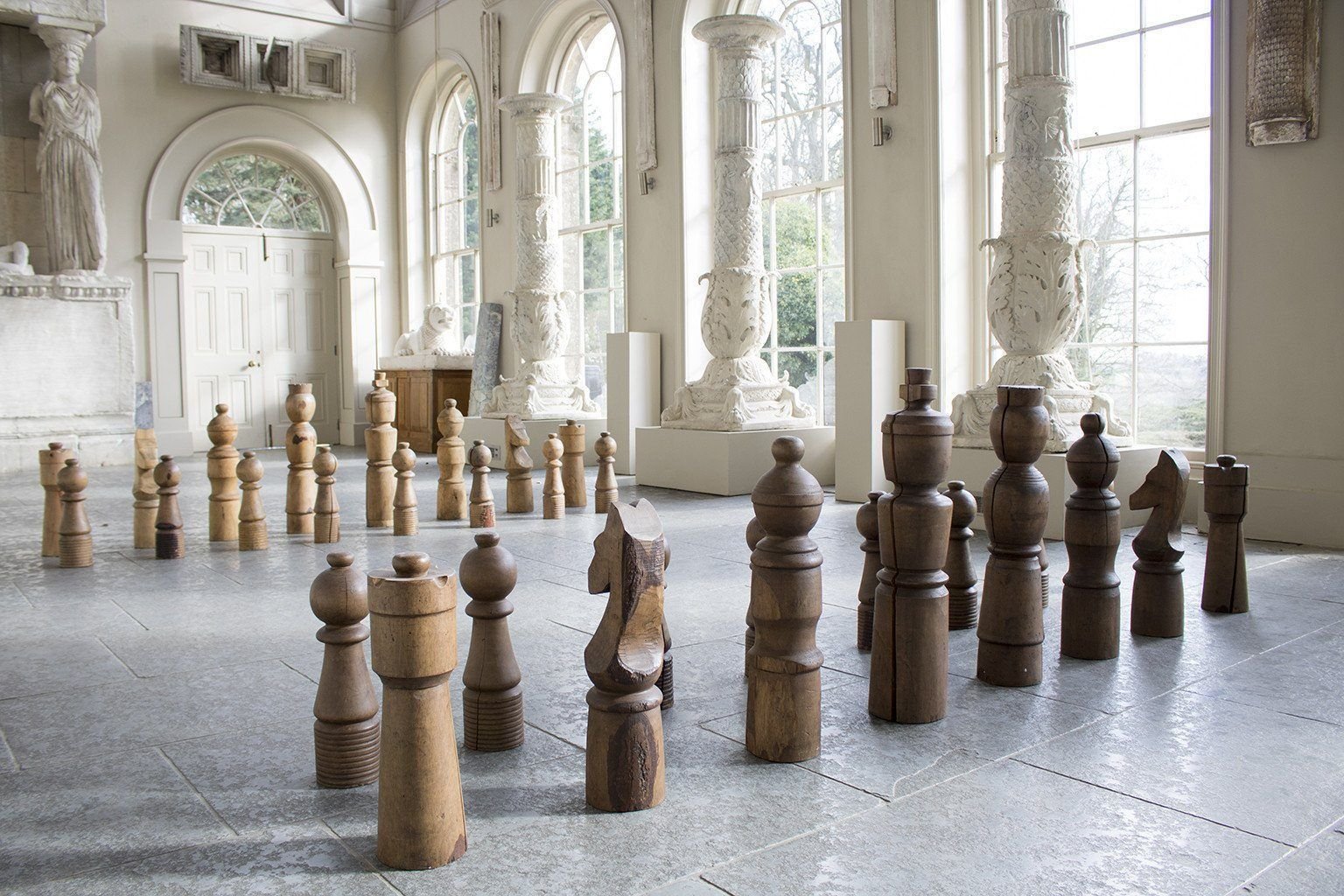Checkmate.
Study #17
The Chess Match, 1916 by Max Oppenheimer
The earliest known form of chess comes from India around 600CE. Chatarunga was a popular two-person game that employed a range of pieces that had different powers and represented the military of the day: the infantry, elephants, the cavalry, and chariots. Owing to growing trade routes, the game eventually made its way to Europe in 1200CE and was consequently modified and romanticized by the nobility who played it.
Marcel Duchamp directing a life-size chess game, 1956
Shatranj (chess set) from Iran, 12th century.
The appearance of chess pieces has alternated between simple and ornate since its inception. Figurative sets depicting animals, warriors, and noblemen have always been popular, while Muslim sets of the 9th–12th centuries were often nonrepresentational and made of simple clay or carved stone due to their aversion of idolatry. Stylized sets, often adorned with jewels, returned to fashion as the game spread to Europe and Russia and became a pastime for royalty and the aristocracy. Peter the Great of Russia had special boards made for him using soft leather so that he could carry them along on military campaigns.
Marcel Duchamp and Salvador Dalí play chess during the filming of a French documentary, 1966.
The standard for modern sets was established about 1835 with a simple design by an Englishman, Nathaniel Cook. After it was patented in 1849, the design was endorsed by Howard Staunton, then the world’s best player, and subsequently became known as the Staunton pattern. Only sets based on this classic design are allowed in international competitions today.
Duchamp playing chess with a Nude (Eve Babitz), 1963
When chess gained popularity in Europe around 1500CE it became a faster, more exciting game and, thus, was perceived as a more masculine pursuit. Women were often barred from the coffeehouses and taverns where chess clubs developed until a few were organized specifically for women in the Netherlands in 1847. The first chess book written by a woman, The ABC of Chess, by “A Lady” (H.I. Cooke), appeared in England in 1860 and the first Women’s World Championship was organized by FIDE in 1927
Playing Chess on Broadway, 1986
A computer known as ‘Deep Thought’ became the first machine to beat a chess champion in 1988. It was created by Feng-Hsiung Hsu and developed at Carnegie Mellon University. It was then improved upon at IBM and a later iteration, ‘Deep Blue’, was finally able to beat grandmaster Garry Kasparov. Its algorithms were simple evaluation functions; it could examine half a billion chess positions per move, which is sufficient to compute 10 or 11 moves ahead.
“Chess players are madmen of a certain quality, the way the artist is supposed to be, and isn’t, in general.” Marcel Duchamp
Besides creating a myriad of works featuring his favorite game, Marcel Duchamp was a gifted chess player. He would often spend chess nights with his friends and patrons, but when it became too much of a scene amongst the Dada set he would escape to South America to plunge himself into study. He achieved a Master Title and represented France in the Olympiads, wrote one chess book, translated another, covered chess for Le Soir newspaper, and became an official of the French Chess Federation.
Bob Dylan
Set by Max Ernst
In the summer of 1944, gallery owner Julien Levy, his wife, and the surrealist couple Max Ernst and Dorothea Tanning rented a house together in Great River, Long Island where they played a prodigious amount of chess. Levy and Ernst, later joined by Marcel Duchamp, conceived of an exhibition on the game, and “The Imagery of Chess” opened at Levy’s gallery in December 1944.
That's what chess is all about. One day you give your opponent a lesson, the next day he gives you one. - Bobby Fischer
In the 1960s young Bobby Fischer became the first American to ever win a chess tournament title. His quirky, inventive and unrelenting style of play captured the spirit of the United States during the Cold War era and introduced a new generation to the game. He remains the only American chess champion to date.
Chess theory consists of opening knowledge, tactics, positional analysis, strategy, and endgame technique. The game is divided into three portions: opening, middlegame and endgame.










